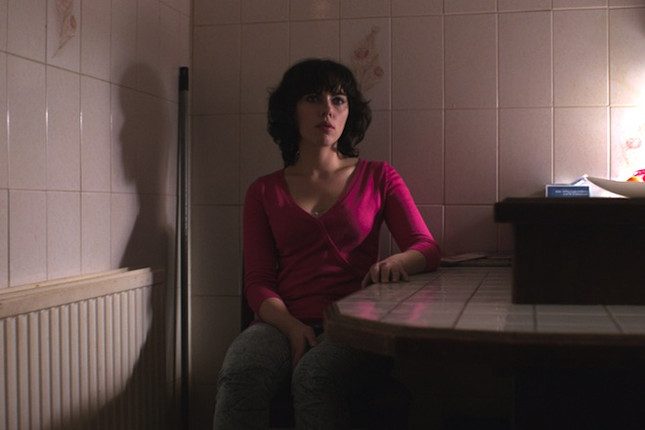About a year and a half ago (before I was writing for any sites), I went to the movie theater to go check out Paul Thomas Anderson’s “The Master,” a film that not only deeply sat with me, but had me thinking for days on end about its rich themes and utterly impressive display of artistry both in front of and behind the camera. It was the kind of film that only comes around every once in every few blue moons: The kind that not only reminds me why I love the art form as much as I do, but why I choose to examine and study it in the first place. I bring this up because Under the Skin is a film that awakened those same feelings in me, and if the wave of thoughts about it still rushing through and blossoming in my mind is anything to go by, I’ll be writing about and talking about, and thinking about this one for an equally long time to come.
In terms of concrete narrative details, Under the Skin is fairly vague with the only completely cemented story points being those of the set-up. Regardless, it remains a narrative film with an ever-evolving emotional center. Revolving around an alien disguised in human form as a beautiful young woman (Scarlett Johansson) on the hunt for prey in both rural and urban Scotland, it follows its central character through what can be boiled down to a series of encounters with locals she’s lured in. Ranging from people looking to help her out, to lonely misfits, to even a backwoods rapist, all of these experiences, in one way or the other, wrap around to form a microcosm of the human experience from the benevolent to the evil, and the majority of them can be derived from one basic desire: Intimacy.
For instance, there exists a scene in the film where a man finds himself submersed in a mass of black ooze after being preyed upon by the alien seductress. Completely unaware of what’s happening and where he is, he spots a previous victim floating in front of him, visibly physically altered by his time in the substance. Without a second’s thought, the man’s first instinct is not to try to struggle and escape, but to reach out and hold hands with this complete stranger. It’s a simple, but beautiful and poignant scene. One that encapsulates the film’s knack for visually illustrating its thematic motifs, and one that demonstrates how desperately we crave human connection, whatever it may be, in times of ultimate crisis. Similarly, Johansson queries, “when was the last time you touched someone?” to a man with a disfigured face before having him feel her face and neck. When considering the importance the film places on connectivity (both physical and psychological), it’s no wonder this man, who is a pariah as the alien is a foreigner, is the only would-be victim she allows to live.
In fact, Jonathan Glazer puts equal and related emphasis on what it means to be an outsider. Despite being a predator, Johansson’s alien is never really villainized. Instead, she appears meant to serve as a neutral observer of our world from an exterior perspective. Whenever she isn’t attempting to reel in prey, all of Johansson’s facial expressions and gestures suggest a sense of either anxiety or maybe even fear of the unfamiliar world surrounding her. A feeling accentuated by the camerawork as POV and low-angle tracking shots move quickly and anxiously across and through crowds of people, giving audiences a feel for the central character’s stress and claustrophobia. As the movie runs on, her feelings progress from fright to curiosity as this strange new world and its inhabitants begin to open up, coinciding with her increased yet never fully consummated comfort in her environment.
Being about an 80% dialogue-free role, the immense burden of visually communicating all these emotions fall squarely on Johansson’s shoulders, and she meets the most adventurous acting project she has ever attempted head-on. While mostly silent, her alien is never an empty shell because of the actress’s profound talent for utilizing body language to communicate her character’s inner thoughts. It’s an immensely difficult thing to perfect, let alone pull off consistently over the course of a two hour film, but Johansson imbues every movement with meaning, delivering a performance that is the physical equal (maybe even superior) to her stunning vocal turn in Spike Jonze’s “Her” mere months ago. Also showcasing career-high work is director Jonathan Glazer, who remains as indebted to Kubrick’s style as he ever has without ever resorting to cheap mimicry. In addition to most shots looking good enough to hang on a wall, Glazer expertly manipulates motion, light, and sound, weaving them into a hypnotic visual and aural tapestry that simultaneously entrances and unnerves. Rarely ever has a film felt like it could have come from another planet as much as this one.
Under the Skin is both the warmest and coldest film I can immediately remember viewing in a theater. While its aesthetic design is distant and otherworldly, its themes and ideas come from a profoundly humanistic mindset that privileges our relationship to others above all else. It is admittedly a quite difficult film to get a good foothold on, but those who are willing to invest the patience into its seeming ambiguity will find a disturbing yet truly lyrical look at life on earth. Perhaps most telling is that I went to sleep last night thinking about it and woke up this morning doing the same. That is the mark of something special.






'Movie Review: Under the Skin (2013)' have 2 comments
April 19, 2014 @ 8:20 pm Hamper
I’m surprised to hear it was so good. The trailer I saw for it made it look like a drawn out bore.
June 18, 2014 @ 4:37 pm Cat_on_Keyboard
Good review–you saw much deeper into this than I. Within the first 10 minutes I knew this wasn’t the picture for me. It felt like I was watching a minimalist film experiment testing the patience of the audience.